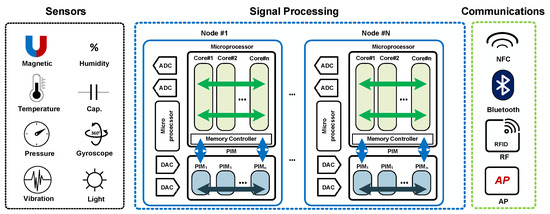Integrated Circuits and Systems for Smart Sensor Applications
Share This Topical Collection
Editors
 Dr. Francesc Serra-Graells
Dr. Francesc Serra-Graells
 Dr. Francesc Serra-Graells
Dr. Francesc Serra-Graells
E-Mail
Website
Collection Editor
1. Institut de Microelectrònica de Barcelona IMB-CNM (CSIC), 08193 Barcelona, Spain
2. Dept. of Microelectronics and Electronic Systems, Universitat Autònoma de Barcelona, 08193 Barcelona, Spain
Interests: integrated circuits; ASIC; ROIC; CMOS; low-power; mixed-signal; hearing aids; IR and X-ray digital imagers; low-cost smart chemical sensors; integrated smart N/MEMS sensors; massive neural recording systems; high-resolution space instruments
 Prof. Dr. Kyoungrok Cho
Prof. Dr. Kyoungrok Cho
 Prof. Dr. Kyoungrok Cho
Prof. Dr. Kyoungrok Cho
E-Mail
Website
Collection Editor
Department of Information and Communication Engineering College of Electrical and Computer Engineering, Chungbuk National University, Cheongju 362763, Korea
Interests: low-power and high speed digital circuit design; artificial retina modeling; memristor-CMOS logic design, neuromorphic circuits; CMOS image sensors; LVDS and MIPI interface circuits; IoT sensor applications; embedded controller design
Topical Collection Information
Dear Colleagues,
Connected intelligent sensing reshapes our society by empowering people with increasing new ways of mutual interactions. As integration technologies keep their scaling roadmap, the horizon of sensor applications is rapidly widening thanks to myriad lightweight self-powered smart devices with high-connectivity capabilities. Furthermore, the cost-effective large-scale manufacturing associated with these integration technologies makes their usage in low-end and disposable sensing devices also possible. In any case, integrated circuits based on CMOS technologies is clearly the best candidate to supply the required smartness and to pioneer these emerging sensor systems. As a result, new challenges are arising around the design of these integrated circuits and systems for sensor applications in terms of low-power edge computing, remote and self-powering strategies, low-range wireless communications, and low-cost device packaging.
This Special Issue aims to track the recent advances in application-specific integrated circuits and systems for smart sensor applications among, but not limited to, the following emerging topics:
- Wearable systems capable of combining physical and chemical sensing of the body and environment;
- Self-powered autonomous systems, including miniaturized sensing fuel cells, for the recognition of chemical analytes;
- Smart swallowable pills for in-body diagnostic and drug delivery;
- Implantable devices for multiparametric physiological monitoring and for neural signal recording and tracking;
- Disposables smart devices, such as sensing tags for perishable goods;
- Hybrid sensors combining smart integrated circuits and low-cost large-area printed electronics.
Dr. Francesc Serra-Graells
Prof. Dr. Kyoungrok Cho
Dr. Michele Dei
Collection Editors
Manuscript Submission Information
Manuscripts should be submitted online at www.mdpi.com by registering and logging in to this website. Once you are registered, click here to go to the submission form. Manuscripts can be submitted until the deadline. All submissions that pass pre-check are peer-reviewed. Accepted papers will be published continuously in the journal (as soon as accepted) and will be listed together on the collection website. Research articles, review articles as well as short communications are invited. For planned papers, a title and short abstract (about 100 words) can be sent to the Editorial Office for announcement on this website.
Submitted manuscripts should not have been published previously, nor be under consideration for publication elsewhere (except conference proceedings papers). All manuscripts are thoroughly refereed through a single-blind peer-review process. A guide for authors and other relevant information for submission of manuscripts is available on the Instructions for Authors page. Sensors is an international peer-reviewed open access semimonthly journal published by MDPI.
Please visit the Instructions for Authors page before submitting a manuscript.
The Article Processing Charge (APC) for publication in this open access journal is 2600 CHF (Swiss Francs).
Submitted papers should be well formatted and use good English. Authors may use MDPI's
English editing service prior to publication or during author revisions.
Keywords
- Smart sensors
- Integrated circuits and systems
- CMOS
- Wearable
- Self-powered
- Disposable
- Swallowable
- Implantable
- Printed electronics
Published Papers (2 papers)
Open AccessReview
A Review: The Beauty of Serendipity Between Integrated Circuit Security and Artificial Intelligence
by
Chen Dong, Decheng Qiu, Bolun Li, Yang Yang, Chenxi Lyu, Dong Cheng, Hao Zhang and Zhenyi Chen
Viewed by 973
Abstract
Integrated circuits are the core of a cyber-physical system, where tens of billions of components are integrated into a tiny silicon chip to conduct complex functions. To maximize utilities, the design and manufacturing life cycle of integrated circuits rely on numerous untrustworthy third
[...] Read more.
Integrated circuits are the core of a cyber-physical system, where tens of billions of components are integrated into a tiny silicon chip to conduct complex functions. To maximize utilities, the design and manufacturing life cycle of integrated circuits rely on numerous untrustworthy third parties, forming a global supply chain model. At the same time, this model produces unpredictable and catastrophic issues, threatening the security of individuals and countries. As for guaranteeing the security of ultra-highly integrated chips, detecting slight abnormalities caused by malicious behavior in the current and voltage is challenging, as is achieving computability within a reasonable time and obtaining a golden reference chip; however, artificial intelligence can make everything possible. For the first time, this paper presents a systematic review of artificial-intelligence-based integrated circuit security approaches, focusing on the latest attack and defense strategies. First, the security threats of integrated circuits are analyzed. For one of several key threats to integrated circuits, hardware Trojans, existing attack models are divided into several categories and discussed in detail. Then, for summarizing and comparing the numerous existing artificial-intelligence-based defense strategies, traditional and advanced artificial-intelligence-based approaches are listed. Finally, open issues on artificial-intelligence-based integrated circuit security are discussed from three perspectives: in-depth exploration of hardware Trojans, combination of artificial intelligence, and security strategies involving the entire life cycle. Based on the rapid development of artificial intelligence and the initial successful combination with integrated circuit security, this paper offers a glimpse into their intriguing intersection, aiming to draw greater attention to these issues.
Full article
►▼
Show Figures
Open AccessArticle
An N-Type Pseudo-Static eDRAM Macro with Reduced Access Time for High-Speed Processing-in-Memory in Intelligent Sensor Hub Applications
by
Subin Kim, Ingu Jeong and Jun-Eun Park
Viewed by 1971
Abstract
This paper introduces an n-type pseudo-static gain cell (PS-nGC) embedded within dynamic random-access memory (eDRAM) for high-speed processing-in-memory (PIM) applications. The PS-nGC leverages a two-transistor (2T) gain cell and employs an n-type pseudo-static leakage compensation (n-type PSLC) circuit to significantly extend the eDRAM’s
[...] Read more.
This paper introduces an n-type pseudo-static gain cell (PS-nGC) embedded within dynamic random-access memory (eDRAM) for high-speed processing-in-memory (PIM) applications. The PS-nGC leverages a two-transistor (2T) gain cell and employs an n-type pseudo-static leakage compensation (n-type PSLC) circuit to significantly extend the eDRAM’s retention time. The implementation of a homogeneous NMOS-based 2T gain cell not only reduces write access times but also benefits from a boosted write wordline technique. In a comparison with the previous pseudo-static gain cell design, the proposed PS-nGC exhibits improvements in write and read access times, achieving 3.27 times and 1.81 times reductions in write access time and read access time, respectively. Furthermore, the PS-nGC demonstrates versatility by accommodating a wide supply voltage range, spanning from 0.7 to 1.2 V, while maintaining an operating frequency of 667 MHz. Fabricated using a 28 nm complementary metal oxide semiconductor (CMOS) process, the prototype features an efficient active area, occupying a mere 0.284 µm
2 per bitcell for the 4 kb eDRAM macro. Under various operational conditions, including different processes, voltages, and temperatures, the proposed PS-nGC of eDRAM consistently provides speedy and reliable read and write operations.
Full article
►▼
Show Figures










